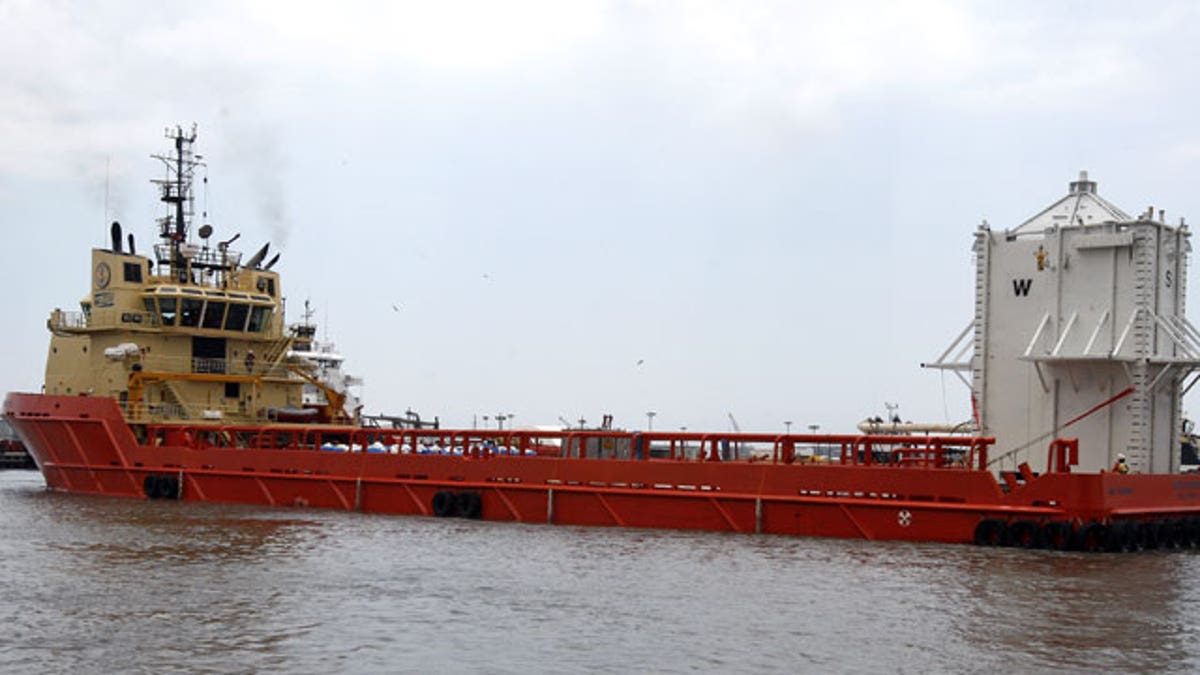
The barge Joe Griffin turns around in a channel after a crane loaded a chamber, right, that will be used to help contain oil leaking from the Deepwater Horizon oil drilling platform, in Port Fourchon, La. (AP)
ON THE GULF OF MEXICO-- It's never been tried before, but crews hope to lower a 100-ton concrete-and-steel box a mile under the Gulf of Mexico on Thursday to cut off most of the hundreds of thousands of gallons of oil spewing from a blown-out well.
If it works, the system could collect as much as 85 percent of the oil that's been leaking from the ocean floor after the Deepwater Horizon rig exploded April 20, killing 11 workers.
"Hopefully, it will work better than they expect," first mate Douglas Peake told The Associated Press aboard the ship that brought the box to the site. The AP is the only news organization with access to the containment effort.
It won't solve the problem altogether. Crews are drilling a relief well to take the pressure off the blown-out well at the site, and that could take up to three months. Other possible solutions are also in the works.
More than 200,000 gallons (757,060 liters) of oil a day is pouring from the well, creating a massive sheen that's been floating on the Gulf for more than two weeks. As it moved closer to land, crews were frantically laying boom and taking other steps to prevent it from oozing into delicate coastal wetlands
A pinkish oily substance was lapping at the shore of New Harbor Island on Thursday, washing into thick marsh grass. It looked like soggy cornflakes, possibly because the oil was mixed with chemicals to break it up before it reached land.
Offshore, birds dove into the water amid lines of orange oil, but none appeared to be in distress. There were numerous dead jellyfish, some washing up on the shore. It's nesting time for sea gulls and pelicans and the danger is they may be taking contaminated food or oil on their feathers to their young.
People don't live on New Harbor, which is in the Chandeleurs, an important chain of barrier islands off Louisiana that are part of a national wildlife refuge and provide an important nesting ground for sea birds.
At sea, some boats were using skimmers to suck up oil while others were corralling and setting fire to it to burn it off the surface.
The Joe Griffin, the ship carrying the containment box that will be lowered to the seafloor, arrived Thursday morning at the leak site about 50 miles (80 kilometers) offshore.
Workers hope to have the device down at the seabed by Thursday evening, but it will likely be Sunday or Monday before it's fully operational and they know if it's working.
The crew won't have to worry about dealing with the wreckage of the Deepwater Horizon, which sank two days after the explosion. It's not anywhere near where they're working.
The waters were calm Thursday. Thick, tar-like oil with a pungent scent surrounded the boat as far as the eye could see.
Another BP-chartered boat will use a crane to lower the box -- something that has never been tried before at such depths. BP spokesman Bill Salvin said the drop is expected at about 1 p.m. EDT (1700 GMT) Thursday.
The Coast Guard was keeping boats not involved in the effort out of a 500-meter (yard) zone around the site.
A 20-foot (6-meter) pleasure boat that invaded the perimeter Thursday and pulled up right in the middle of the oil spill near the boat drilling the relief well was told to leave by a Coast Guard boat. It quickly turned around and left. Boats were also being kept out of a wider area that included the rig drilling the relief well.
Oil has been leaking in three places since the explosion. One small leak was capped Wednesday. The containment box will be lowered over a much bigger leak in a pipe that's responsible for about 85 percent of the oil that's coming out.
The rest of the oil is coming from the blowout preventer at the well, a heavy piece of machinery designed to prevent blowouts that failed in the April 20 explosion. Crews have been trying to shut it off using robotic devices, but that hasn't worked.
If the box being lowered Thursday is successful in containing the bigger leak, a second box being built may be used to stop the smaller leak at the blowout preventer.
The containment box has a dome-like structure at the top that's designed to act like a funnel and siphon the oil up through 5,000 feet of pipe and onto a tanker at the surface.
First, crews need to properly position the four-story structure with the help of a remote-controlled robotic submarine. A steel pipe will then be attached to a tanker at the surface and connected to the top of the dome to move the oil.
That process presents several challenges because of the frigid water temperature -- about 42 degrees Fahrenheit -- and exceptionally high pressure at those depths. Those conditions could cause the pipe to clog with what are known in the drilling industry as "ice plugs." To combat that problem, crews plan to continuously pump warm water and methanol down the pipe to dissolve the clogging.
They are also worried about volatile cocktail of oil, gas and water when it arrives on the ship above. Engineers believe the liquids can be safely separated without an explosion.
Homeland Security Secretary Janet Napolitano said at a briefing in Biloxi, Mississippi, that officials were planning for the worst even though they hoped the device would work.
"If it does, of course, that will be a major positive development," she said.

